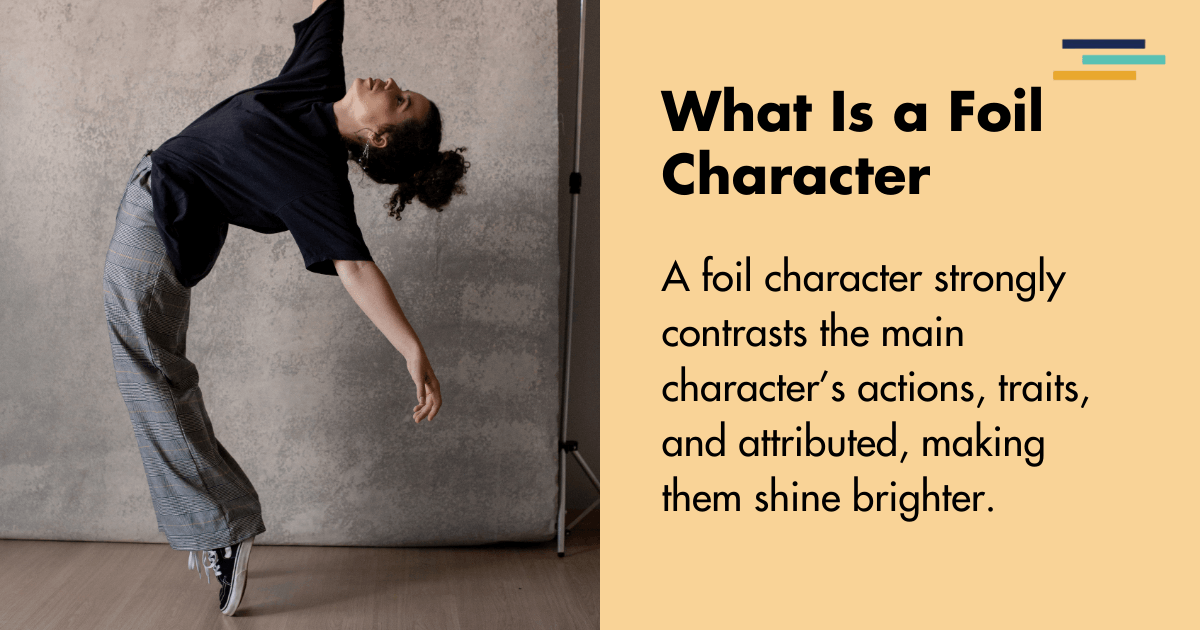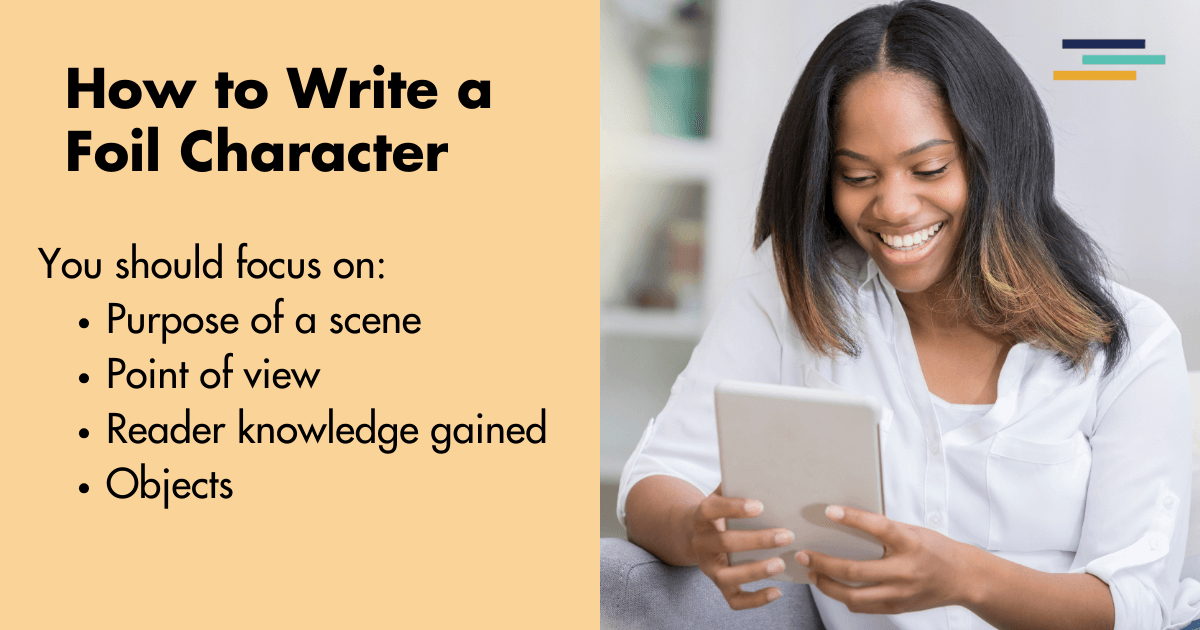 A foil character is one who strongly contrasts with another character (usually a protagonist) in order to highlight the protagonist’s qualities.
A foil character is one who strongly contrasts with another character (usually a protagonist) in order to highlight the protagonist’s qualities.
Let’s look further into what a foil character is, why they are important, some examples, and how to write them.
What is a Foil Character?
In jewelry making, a foil is a thin sheet of metal placed behind a gemstone to help it reflect more light, which makes the gem appear brighter.
In story writing, a foil character highlights aspects of the main character’s attributes, traits, or actions, which makes the main character shine brighter by contrast.
A foil is a powerful tool writers can use to enhance the protagonist’s characterization, showcasing facets of their personality that might otherwise be overlooked.
Foil Character Definition
When writing fiction, a foil character is someone whose qualities contrast and accentuate the protagonist’s most important personality traits. Literary foils reveal something about the main character that readers might not notice. Scenes between the foil character and the protagonist can show a hidden side of the personality that is eye-opening, unlike any other interaction in the story.
By providing an illuminating contrast, the foil character’s personality traits and actions cause the protagonist to stand out, appearing more nuanced and engaging. The reader will be drawn into a deeper assessment of the protagonist when the foil stands beside them.
One way to highlight the dimensions of a main character is to put them on display. For example, a slow-talking, contemplative cowboy will seem all the more reserved if a scene shows him entering a barroom full of raucous fellow cowboys, all carousing at full volume.
One way to showcase how one set of lovers are devoted to each other is to sit them at a table with another couple who are bickering and headed for a breakup.

Most of the time, foils are secondary characters. They can attract labels like sidekick, boon companion, best friend, wing-man or woman, and confidant.
For example, Arthur Conan Doyle’s Dr. Watson, with his practical, unpretentious, and supportive demeanor is a foil to Sherlock Holmes, the brilliant yet egotistical detective. Or the amiable but bumbling Bertie Wooster is a foil to his ingenious valet, Jeeves, in the series of short stories by P. G. Wodehouse.
When the reader has the benefit of seeing the protagonist and the foil together, comparisons between the two can be drawn more easily. The contrast allows the reader to gain a stronger understanding of what drives the protagonist and how they are propelled toward their story goal.
Not all foil characters take on a subordinate role. For example, a foil to the main character could also be an antagonist. How often has the villain in a story said something like “You know, we are not so different, you and me”? The distinction between the good guy and the bad guy is brought home to the reader when a situation leads them to ponder why these two characters chose opposite paths.
A foil could also be a subplot. Instead of a foil character in the main storyline, the same function can be created by weaving in a less extensive plot that parallels the main character’s path. In the subplot, the foil character may not be physically in the same scenes together in the story world, but by example their actions invite the reader to make comparisons regarding the protagonist’s choices.
A foil, in yet another form, could be a setting. Placing the protagonist in a setting that puts them at a disadvantage, out of their normal comfort zone, or in an environment where their personality traits clash with others, plays up their intrinsic nature and expresses their regular habits. The strange surroundings can show how the protagonist struggles toward their goal, in sharp relief to those who are comfortable and belong in that setting.
A popular trope shows the country boy going to the big city and either climbing to the top or returning home sadder but wiser. The city girl who goes to the country often ruins her high-heeled shoes and breaks her painted fingernails, but sometimes she develops a new-found inner strength or finds a new motivation to carve herself a place in her new-found world.
Additionally, a foil can be an object or situation. If the protagonist over- or under-dresses for a party or an important business meeting, it proves they are out of sync in their story world. A pair of roommates might be at odds when one is habitually messy and the other prefers everything tidy. The familiars chosen by Harry Potter and his best friends are telling examples of how each of them negotiates the hazards of their wizarding world.
Do You Need Foil Characters in Writing?
There are plenty of stories that don’t use or need foil characters. Strong protagonists with clear goals can be interesting and appealing without foil characters to point out their unique characteristics, but foils are excellent tools for adding complexity and depth.
Foils can draw attention to specific aspects of the main character, highlighting their strengths and weaknesses through comparison or through contrast.
Foils provide a backdrop for the reader, against which the protagonist’s behavior and attitude can be evaluated. The foil shows an example of how someone else works within the main character’s everyday world. The reader is given a clearer picture of alternate ways someone might interact within their given environment.
The foil might approach the same story problem as the protagonist, but by light of their own personal goals or beliefs, end up with an entirely different outcome. This emphasizes the choice and motivations of the main character. The contrast between the choices made by the foil and the protagonist will accentuate the success or failure of the story’s climax.
A foil is the perfect device for moving the story forward. Once the foil character acts, the protagonist can react in turn. If the protagonist makes a bold move, the foil’s reaction provides another perspective on how that move changed the plot. If the protagonist enters a conflict, whether the foil character joins in the fray or holds back gives the reader yet another perspective on the scene.
Foils also shed light on themes in a story. When confronted with the underlying deeper meaning that a narrative might have at its core, the foil character can function like a counter-argument, a footnote, or an alternate history.
The reader is rooting for the protagonist and follows along with the hope that they reach their goal and fulfill the story promise. The foil might fare better or worse than the protagonist, but by example they clarify what the protagonist was searching for all along.
How To Write a Character Foil
Keeping track of the trajectory of foil characters and devices in a story is one way to guide the reader toward understanding the story and characters from the beginning to the climax scene. Fictionary provides ways to track all the story elements needed to write a good story. Areas of focus for foil characters include:
Purpose of a Scene
If a scene is a “character introduction,” it’s a great place to check whether a new character is acting as a foil to the protagonist and verify they are doing their job. The foil’s significant characteristics and activities should link up with the protagonist’s, reflecting the nature of their relationship.
Also scenes serving the purposes of establishing the setting, intensifying conflict, or building suspense are points in the storyline where a foil could be used to good advantage. They can create a character-enhancing atmosphere, shine a light on the protagonist’s actions, or show how the foil’s outcome compares to the protagonist’s results.
Point of View
Foils are often good choices for POV characters. Because they are close to the protagonist, they may be present for much of the plot. Thus they are uniquely positioned to draw the kind of conclusions a reader would regarding story goals and stakes.
Reader Knowledge Gained
In scenes where the protagonist is not present but the foil is, what the reader learns in the course of that scene creates a “knowledge gap.” The readers knows more than the protagonist, which creates tension (anticipation that something bad might happen), and a sense of foreboding or foreshadowing that a future conflict will arise in later scenes.
This happens, for example, in a horror story when the reader knows the bad guy is waiting behind the door with a carving knife, but the hero charges on, unaware of his fate!
Objects
If the story has inanimate objects that provide a contrasting image, they can be tracked similarly to a foil character, looking at first scenes, purpose of scenes, and reader knowledge gained. Maybe even giving the object the point of view if it magically speaks.

Foil Character Examples
The mystery genre is replete with dynamic duos such as Holmes and Watson, Poirot and Hastings, and Nick and Nora Charles, each pair with complementary skills to each other.
For an example from today’s best-seller list, in The Maid by Nita Prose, Molly’s unique observations are counterbalanced by the friends who rally to her side. In time, Molly connects her inner strengths with the guidance provided by her friends to solve the mystery.
Other genres make use of foil characters as well, such as:
Fourth Wing by Rebecca Yarros, the blockbuster romantasy novel. The novel invites comparisons of the heroine’s frail health, diminutive size, and training as a scribe, all of which are attributes that are strikingly different from the robust, dragon-riding prowess of her fellow cadets. Violet appreciates and adopts the traits that will serve her best in the new world she finds herself thrust into.
In Goodread’s Choice winning novel for science fiction, In the Lives of Puppets by T.J. Klune, a boy is raised with a family of robots, highlighting dividing lines between what it means to be human or not, and it explores the best and worst of both.
Character Foils Conclusion
In narrative fiction, writers juxtapose foil characters with the main character to underscore actions, habits, and quirks essential to understanding the story goal. Narrative foils focus the reader’s attention on details and mannerisms that might otherwise be overlooked.
Sometimes the foil is the opposite of the protagonist in terms of personality or motivation. Sometimes they are similar in their approach to their goals but they choose different paths. Sometimes the foil is directly in opposition to the main character, fighting against them in the quest for the same final reward.
Scenes where the foil character and the protagonist interact make a profound statement by showing what choices are available in the story world and giving prominence to the choice the protagonist makes.
Whatever the kind of difference between the protagonist and foil character, the end result allows the reader to gain insight from seeing each side by side.


